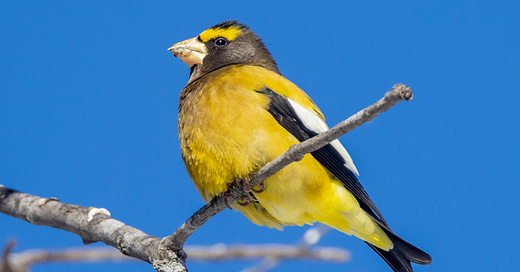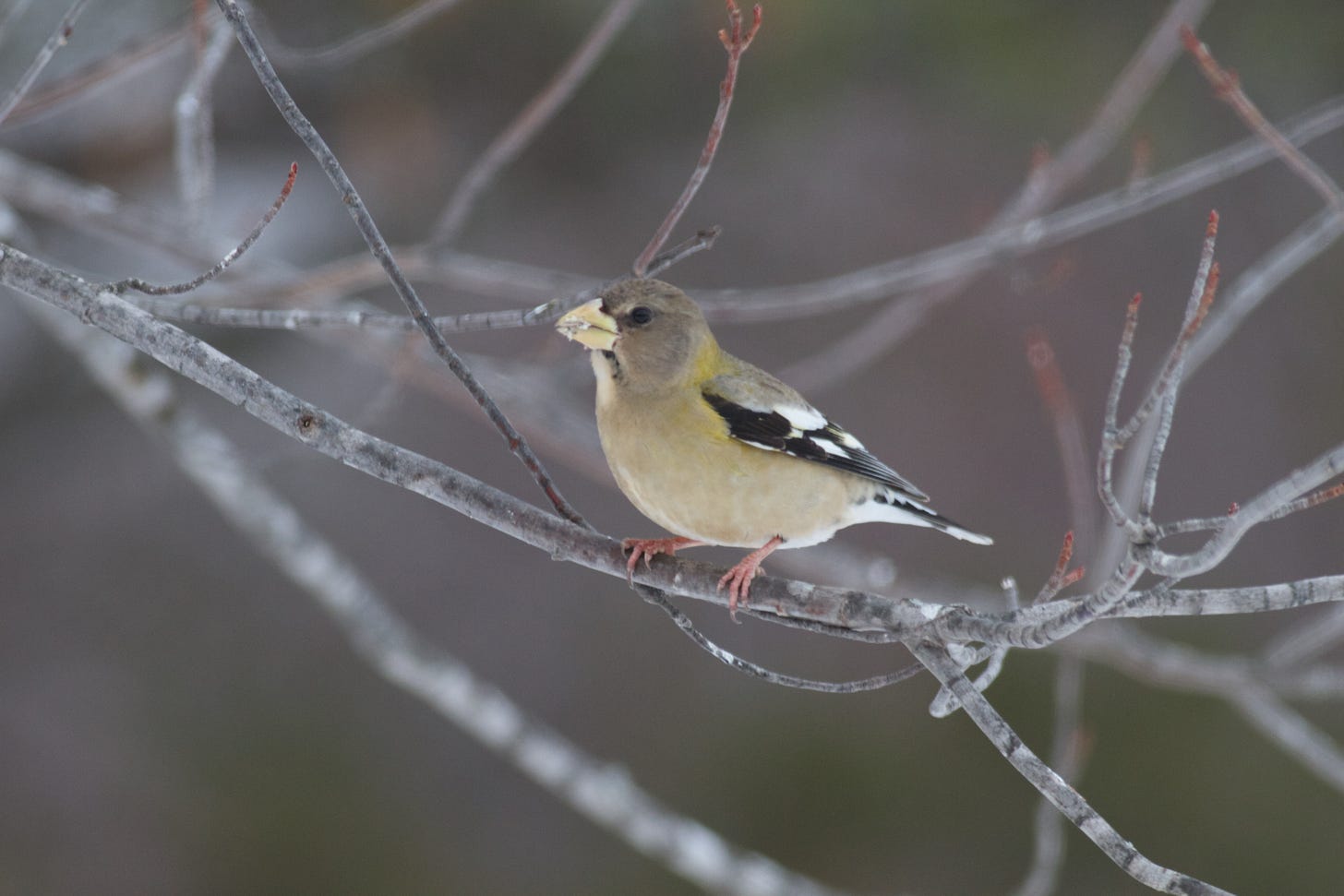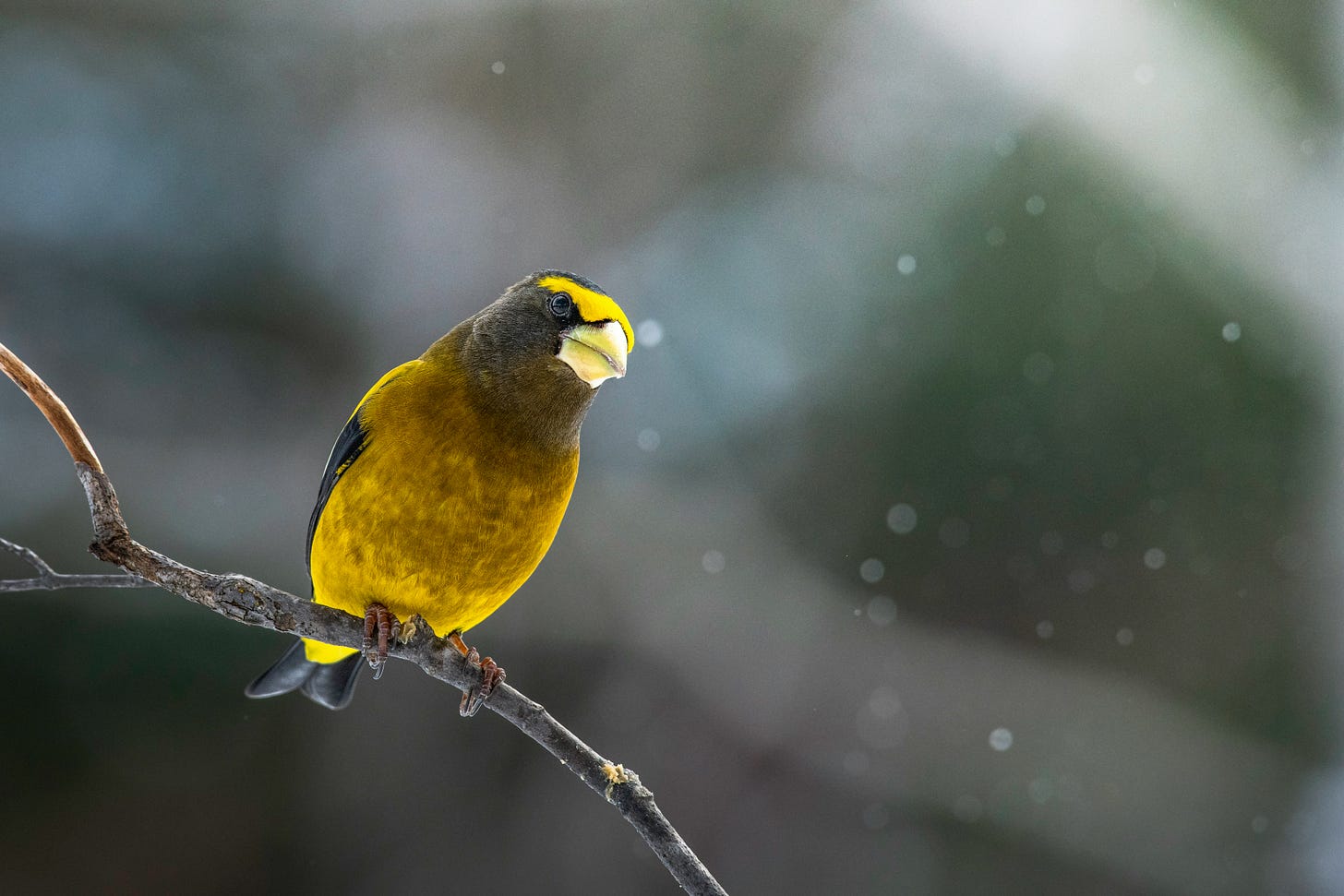The Northern Naturalist # 14
Evening Grosbeaks, How to Plan a Birding Trip, Review of Gardener's World, plus News and Notes
Evening Grosbeak
“Wham!” The door slammed open, two Ruffed Grouse dashed off, and the big flock of Evening Grosbeaks exploded into the sky. A grizzled resident emerged from the house, clad in a long underwear union suit barely covered by an overall hooked only on one side. He wore an insulated cap with earflaps sticking straight out to the side. “Did you see my partridge?” he hollered, and then added, “A goddamn ten-point buck ate all my apples!” He made it to his mailbox and headed back in, mail scrunched in his fist.
“What’s a partridge?” said one of my guiding clients. “That’s the grouse,” I replied. Both of my companions stood agape for a few seconds. One of them (a filmmaker) said, “Well, that made the entire trip worth it.”
This was no small statement. They had come from Southern California. One of them had never experienced a northern winter before, and they had landed on a weekend when the high temperatures were -20° F. They couldn’t believe how few individual birds we saw in two long days in the woods, calculating a high cost per bird, and an especially high cost per lifer.
But they did get the lifers they came to see: Pine Grosbeak, Great Gray Owl, Boreal Chickadee, Black-backed Woodpecker, Hoary Redpoll, and now, Evening Grosbeaks.
In those days, Evening Grosbeaks (Coccothraustes vespertinus) were among the easiest on that list of target species.
This incident happened in Isabella, on the edge of the Superior National Forest. The grouse and Evening Grosbeaks were in a front yard apple tree, part of a beautiful scene—the tree loaded with snow, and the yellow, black, and white of the birds like ornaments on the branches.
Evening Grosbeaks are big finches with large, pale bills. The males have dark heads with a black crown and yellow on the face. They have noticeable white wing patches. Females are mostly grayish-brown with muted yellows and blacks. The birds make loud churr trills, and a flock can be raucous.
In the eighties and nineties, Evening Grosbeaks were fairly common sights in winter in our area. They nest in southern Canada and the most northern tier of U.S. states. Like the other “winter finches,” they are irruptive, sometimes showing up in much larger numbers in winter. I have heard them referred to as “feeder pigs” more than once, because a flock of Evening Grosbeaks will empty a feeder of sunflower or safflower seeds quickly.
In the nineties, their numbers started to dwindle here, and for maybe ten years, it was unusual to see any. Then, about ten years ago, they started to show up again. They are still not common, but I have already seen more this winter than I have in quite some time.
Due to this fluctuating population, there’s a lot of research interest in Evening Grosbeaks. It’s a difficult species to track. Their irruptive nature has always meant that their numbers would fluctuate in places. In addition, over the course of the past 100 years, they have expanded their range significantly from west to east. One theory is that Box Elder (Acer negundo) trees were planted in many towns and cities through the first part of the twentieth century. Evening Grosbeaks like to eat the samaras (papery, winged fruit) of Box Elders, and this expanded food supply may have allowed them to extend their range.
Evening Grosbeak numbers are linked to outbreaks of Spruce Budworm (Choristoneura spp.) These are moth species that can defoliate large tracts of coniferous forest. Firs and spruce are susceptible, and the caterpillars are a preferred food of the grosbeaks. Outbreaks happen every 25-40 years. We had an outbreak in the 1970s, and that may have led to an extraordinary increase in the population in the 1980s.
Between the budworm outbreaks, the range expansion, and the irruptive behavior of Evening Grosbeaks, it is difficult to tell what is going on. The Finch Research Network has begun more extensive tracking of Evening Grosbeaks, and this may provide more answers. It’s plausible that large-scale efforts to chemically suppress spruce budworm outbreaks are influencing grosbeaks. I hope that the small increases we have seen here are indications that we’ll be on the upswing again soon.
These birds seem to be more susceptible to window kills than some others. If you feed birds, you can help prevent this by keeping your feeders either very close to your windows, or at least twenty feet away from your windows. Many window strikes happen when a flock is spooked by a predator (or perceived predator). If the feeder is close to the window, the birds won’t have built enough momentum to be harmed if they hit the window. If the feeder is far enough away from the window, they may have enough flight time to realize that they are headed for a window.
On a trip on the Gunflint Trail years ago, my group stopped to look at a beautiful patch of Fringed Polygala (Polygaloides paucifolia).
As we walked back to the cars, we saw movement underneath the vehicles. It turned out to be Evening Grosbeaks, walking under the cars and occasionally fluttering up to pick bugs off the underside. Their striking, unusual coloration makes them a welcome sight, whenever they show up.
How to Plan a Birding Trip
My birding trips work better if I plan each trip carefully, with an eye to maximizing the birds I find and minimizing the expense and duplication of effort. The principles I use can apply to any birding trip(s): a big day, big year, trip to a new part of the country or world in search of target species, Christmas Bird Count, or really, any trip with an objective.
Survey the possibilities. Begin by assessing the possible species you might find in the area you will visit. I sort these possibilities into these groups:
Key Species: sometimes you are making the trip specifically for one, or a few, species. These go here. For example, I have taken several birding trips along the western border of Minnesota in early spring, in hopes of seeing a Ferruginous Hawk. They nest in the Dakotas, and rarely, they drift over the border into Minnesota. For these trips, that’s my key species.
Likely: this group is for species you expect to see—you’ll be surprised if you don’t see them. You need to be aware of these only to the extent that you need a reminder to look for them. In summer, you don’t need to give the slightest thought to finding an American Robin, but in winter, you might need a reminder to check certain fruit trees.
Probable: birds you wouldn’t be surprised to see, nor would you be surprised to miss them. Just learn as much as you can about their sounds, preferred habitats, and identification clues in advance.
Possible: species that you don’t expect, but others have seen them in your area and time frame, or they ought to be in your area because of range and habitat preferences. You want to be ready for these, just in case.
I recommend organizing your movements around key species, followed by possible species. It’s obvious why you’d include key species; planning for possible species gives you the best chance at the biggest list. When I lead groups, I plan this way. We almost always get the Likely and Probable birds as a matter of course.
On the BRRRdathon described later in this newsletter, for which we have 15 years of trial-and-error to draw upon, our key species were the expected wintering birds here (like winter ducks, finches, corvids—crows, jays, and magpie, and feeder birds). To get those species, we know we need to scour Duluth and the harbor and to visit the Sax-Zim Bog. Once we have built in enough time for these areas, we start thinking about “possible” birds. Given the time (two short-daylight days), we could extend our range to several other areas: the Canadian border region, further west in Minnesota, driving up the North Shore of Lake Superior, or driving to Ashland, Wisconsin, a couple of hours east of here.
We opted for Ashland, where birders have been seeing Tundra Swans and Snowy Owls; in addition, Ashland often has wintering ducks that we might not have here in Duluth. So we drove over to Ashland, hitting the high spots, and then driving home in the dark. As it turned out, we did not get any swans or owls there, and we found only one duck—Gadwall. But along the way, we saw Swamp Sparrow, American Tree Sparrow, and Red-winged Blackbird. None of these was expected, so the trip wasn’t a wash.
If my trip is more complicated, as when I birded in Southeastern Arizona or South Texas, I learned as much as I could in advance. Today there are books or at least websites for many areas, ebird.org and other sites show recent sightings, and some places have Rare Bird Alerts (formerly all voice-telephone-based, but now usually listservs and text groups.) Once I collected a pile of data about all the birds I might see—key species, plus likely, probable, and possible species—I began laying out an itinerary, making sure I hit all the key species, and then filling in possible species at each stop along the way.
As I journeyed through my trip, I could cross off species that I had already seen, allowing me to narrow my focus to those birds that I still needed. In some cases, I could even remove potential stops on the itinerary, since there was nothing new to find there.
Think through your itinerary.
As with any outdoor trip, weather or other factors might mess up your plan, so for key species, it’s great to have more than one potential stop if it’s possible.
You’ll also want to consider light. The times of sunrise and sunset are important, but it’s also good to be aware of direction of view, for example. You don’t want to end up scanning a sewage pond to your west just the sun sets if you can avoid it. You’ll be seeing silhouettes and not much else.
In the case of a big day during spring migration, when there are so many species pushing through that you will be likely to miss some of them no matter what your plan, you might be planning visits to key habitats rather than key species. For a winter birdathon, you’ll want to give yourself at least one chance at every probable species, and you’ll be hoping some possibles will turn up by accident.
Search for rarities—you’ll find the common birds along the way.
Birders are sometimes caricatured for their obsessive focus on finding rarities, and I will readily confess to being compulsive and obsessive sometimes about rare birds. However, most often, birders are not only experiencing the rarity that brought them to a particular area; they are seeing a lot of other birds along the way, plus the landscape, plants, and other animals. Searching for rarities pushes you to use your skills and to learn about new areas, routes, and experiences.
Of course, birding trips require all the logistic planning you do for any kind of trip; and you need to prepare for whatever conditions you’ll be dealing with. Maybe this is all common sense to you, but I hope it helps.

Review of Gardener’s World, a British television show
What, you ask, is a review of a tv show about British gardens doing in a newsletter devoted to nature in the North Woods of North America? Among other reasons, this show will likely inspire you to get outdoors, you will almost undoubtedly learn a lot from it, it’s one of the most enjoyable and well-done programs I have watched, and it’s a special treat in winter, when our colors here (or should I write “colours”) are reduced.
Gardener’s World has been running on the BBC since 1968! Each episode opens with a host (currently Monty Don, accompanied by his dog, Ned), and then over the hour, the episodes include visits by other hosts to notable gardens around Britain, vignettes about people with unusually passionate garden interests, visits to garden-based projects (often places where a garden is reclaimed from abandonment or a garden is developed in an urban environment), and instructional segments about seasonal tasks or plants in the garden
My favorites are segments that are visits to “allotments.” An allotment in England is like a community garden in the U.S. There are currently over 300,000 plots there. Sometimes a story about what someone’s allotment means to them is truly moving.
The programs entail 60 minutes of watching gorgeous footage of plants and landscapes (and birds!), calm music, smooth editing, measured pace, and listening to interesting people discuss gardening and nature. There’s a strong sensibility of gardening naturally, and I have learned a fair amount about pollination, for example, by watching. Knowing how hard it can be to get photos of invertebrates and birds, I am impressed with how much of that gets into the programs.
Gardener’s World is only available in the U.S., so far as I know, on BritBox, which currently costs $8.99 a month. If you subscribe, you can also catch up on episodes of Poirot and other British television. Even if you don’t subscribe, you can watch clips of the show on the Gardener’s World website.
It’s not as good as being outside, but it’s the best streaming I know.
News and Notes
The Friends of Sax-Zim Bog BRRRdathon: World’s Coldest Birdathon
I participated in this birding competition last weekend with my team, the Grousing Twitchers (Brits sometimes call checking off birds on a checklist “twitching.”). Lars Benson, John Ellis, Alex Ellis, and I spent two days traveling around Northern Minnesota and Northwestern Wisconsin trying to find as many species as we could.

We have participated in this event for 15 years. This year we finished with 59 species, our third best; we won our category, and John once again raised the most money for the Friends of Sax-Zim Bog. This year, the event lived up to its frigid reputation:
Our best sightings were two Great Gray Owls interacting as they flew around and across County Road 7 in the bog, a Boreal Owl northwest of Two Harbors, Iceland and Glaucous gulls in Duluth, plus the collection of ducks that has been wintering in Duluth this year, including Harlequin Duck and White-winged Scoter. We had a Boreal Chickadee on Admiral Road in the bog, and we got all the winter finches except Red Crossbill.

It was a good two days. It’s harder to sustain enthusiasm when the birds are harder to find. Some years, we clean up on the first day, and then the second day find little that is new, which makes that day a bit long. This year, we found a lot of new birds on the second day; and we had sunshine both days, which felt great after a couple of gray weeks.
My Big Year Update
My St. Louis County, Minnesota big year is off to a good start. We went for a spin around Duluth on New Year’s Day that yielded ten species, including Harlequin Duck, White-winged Scoter, Ruddy Duck. The Harlequin and the Ruddy Duck were particularly good pick-ups, because in some years, they are hard to come by here.
Then, as noted above, I participated in this year’s BRRRdathon and added another 36 species, including Boreal Owl, Great Gray Owl, Boreal Chickadee, Rough-legged Hawk, Iceland and Glaucous Gull, White-winged Crossbill, and Evening Grosbeak. The Boreal Owl was a great sighting, because they can be extremely difficult to find (although we seem to be at the beginning of a big owl winter.) Winter gulls have been scarce this winter, so it was great to see those too. Boreal Chickadee was nice too—definitely not a gimme (see Issue #3)
Complete Unknown Cardinal
Last week, I saw the movie, A Complete Unknown, which is the tale of a couple of pivotal years in the life of Bob Dylan. Dylan was born in Duluth and grew up in Hibbing, in northern St. Louis County, Minnesota, so there’s extra interest around here.
I enjoyed the movie, but I have one quibble: when Bob travels to California and visits Joan Baez at her cool house, a Northern Cardinal is whooping it up in the background, so the movie house is not in California. I know—we don’t go to movies for the facts, but how could they miss a critically-important detail like this?
A Year Without Redpolls
Ryan Mandelbaum at the Finch Research Network points out that, while we lost the Hoary Redpoll last year, Europeans lost two species of redpoll.
My Neck of the Woods
In writing this newsletter, I have found myself using the phrase, “neck of the woods.” It feels right, but it’s not obvious. “Neck” has been used in English since the seventeenth century as a descriptor for a narrow strip of land or forest, and “neck of the woods” has been in print since the middle of the nineteenth. It could have been “leg of the woods,” I suppose, but in any case, thank you for reading here about my neck of the woods.

















My northern Wisconsin boyhood farm in Price County, 1970’s, Mom had a 5gallon pail sunflower platform feeder, near daily consumed by 50-100 Evening Grosbeaks…”they’re eating me out of house n home..” her expressions. My, my, how this common winter event is a scarcity in my adulthood.
Secondly, knowing I was tie at 239 Stearns big year, at 2:00pm Dec 31st, while idea birding past known spots for wintering TSolitaires here, found a Northern Saw Whet instead, for 240. 😌
Great stuff! I particularly liked the link the evening grosbeak call. Thanks for that!